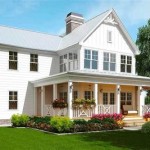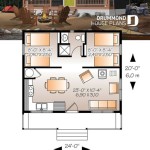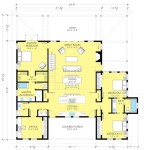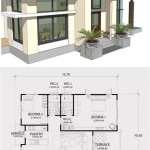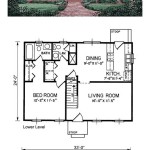House Plans With Garage In Front: Maximizing Available Spaces
The architectural design of a house, particularly the placement of the garage, significantly influences the functionality and aesthetic appeal of the property. House plans featuring a garage in the front are a common choice, often driven by lot size, zoning regulations, and cost considerations. However, integrating a front-facing garage requires careful planning to maximize available space, enhance curb appeal, and maintain a comfortable living environment.
This article explores the various aspects of house plans with a garage in the front, focusing on strategies for optimizing space utilization and mitigating potential drawbacks. It will delve into design considerations, space-saving techniques, landscaping approaches, and architectural styles that complement this type of house layout. The aim is to provide a comprehensive understanding of how to create a functional and aesthetically pleasing home with a front-facing garage that meets the needs of modern living.
Design Considerations for Front-Facing Garages
The decision to place the garage in the front of a house plan is often influenced by the dimensions and shape of the lot. Narrow lots, in particular, may necessitate a front-facing garage as side or rear entry is not feasible. Zoning regulations frequently dictate setback requirements, which further limit the placement options for the garage.
From a cost perspective, a front-facing garage is generally more economical to build than a detached or rear-entry garage. This is because it typically requires less foundation work, shorter driveway lengths, and simpler building connections to the main house structure. However, the perceived drawbacks, such as reduced curb appeal and potential driveway dominance, need to be carefully addressed through thoughtful design.
One of the primary design considerations is the visual impact of the garage door. A large, unadorned garage door can detract from the overall aesthetics of the house. Strategies to mitigate this include using decorative garage doors with windows, panels, or other architectural details. Choosing a garage door material and color that complements the rest of the house's exterior is also crucial.
Furthermore, the placement of windows, doors, and other architectural features should be carefully considered to balance the visual weight of the garage. Strategic landscaping can also help to soften the appearance of the garage and integrate it more seamlessly with the surrounding environment. The orientation of the house on the lot will also play a key role, considering sunlight, prevailing winds, and privacy concerns.
Internal layout is also affected. A front-facing garage ideally connects directly to a mudroom or entry hall, providing convenient access to the house, especially during inclement weather. Thoughtful planning of this transition space can help to minimize clutter and maintain the cleanliness of the main living areas. Storage solutions within this entry point are highly desirable. The garage also needs to be properly insulated if there is living space above it or adjacent to it.
Space-Saving Techniques and Interior Layout Optimization
Maximizing available space within a house with a front-facing garage requires careful consideration of both the garage itself and the adjacent living areas. Efficient storage solutions within the garage are essential. This may involve installing overhead storage racks, shelving units, or wall-mounted organizers to keep tools, equipment, and other items off the floor, freeing up space for vehicles and other uses.
Within the house, open-concept floor plans can help to create a sense of spaciousness and flow, particularly in smaller homes. Connecting the living room, dining area, and kitchen allows for flexible use of space and eliminates the need for unnecessary walls. Strategic placement of furniture and minimal use of bulky items can further enhance the feeling of openness. Maximizing vertical space with tall bookshelves or floor-to-ceiling storage units can also create the illusion of greater height and volume.
The efficient design of hallways and corridors is crucial for minimizing wasted space. Narrow hallways and strategically placed doorways can help to optimize the flow of traffic and maximize the usable area of each room. Pocket doors or sliding doors can be used in areas where swinging doors would impede movement or take up valuable space.
Basement finishing, when possible, can provide additional living space without increasing the footprint of the house. A finished basement can be used for a variety of purposes, such as a recreation room, home office, or guest bedroom. Careful planning of the basement layout, including proper insulation, ventilation, and lighting, is essential for creating a comfortable and functional living environment. Alternatively attic space can serve a similar role.
Another approach is to consider the use of universal design principles, which prioritize accessibility and adaptability. This may involve incorporating wider doorways, grab bars in bathrooms, and ramps or elevators to accommodate individuals with mobility limitations. Universal design elements can make the home more comfortable and usable for people of all ages and abilities, while also potentially increasing its resale value.
Ultimately, effective space-saving techniques and interior layout optimization require a holistic approach that considers the specific needs and preferences of the homeowners, as well as the constraints of the building site and budget. Collaboration with an architect or interior designer can be invaluable in developing a customized plan that maximizes the potential of the available space.
Landscaping and Architectural Styles for Enhanced Curb Appeal
The landscaping surrounding a house with a front-facing garage plays a critical role in enhancing its curb appeal. Thoughtful landscaping can help to soften the appearance of the garage, integrate it more seamlessly with the surrounding environment, and create a more welcoming and attractive facade. Incorporating trees, shrubs, flowers, and other plants can add color, texture, and visual interest to the front yard.
Strategic placement of trees and shrubs can help to screen the garage from view, creating a sense of privacy and seclusion. Consider planting tall, evergreen trees along the sides of the driveway to create a natural barrier and reduce the visual impact of the garage door. Shrubs and flowering plants can be used to soften the edges of the driveway and create a more inviting entry to the house. Vines can be trained to grow on trellises or walls, adding vertical interest and creating a lush, green backdrop.
The choice of architectural style can also significantly influence the curb appeal of a house with a front-facing garage. Certain architectural styles, such as Craftsman, Ranch, and Contemporary, are more conducive to integrating a front-facing garage in a visually appealing and harmonious manner. These styles often feature clean lines, simple forms, and natural materials that complement the garage without overwhelming the overall design.
Craftsman-style homes typically feature wide eaves, exposed rafters, and a covered front porch that provides a welcoming transition from the garage to the main house. Ranch-style homes are characterized by their low-pitched roofs, horizontal orientation, and large windows that bring natural light into the interior. Contemporary-style homes often feature asymmetrical designs, minimalist detailing, and a focus on energy efficiency.
In contrast, more traditional architectural styles, such as Colonial, Victorian, or Tudor, may require more careful planning to incorporate a front-facing garage without detracting from the style’s historical integrity. In these cases, it may be necessary to use design elements such as gables, dormers, or decorative trim to create a more cohesive appearance. Integrating the garage into the overall architectural design requires attention to detail and a deep understanding of the historical context of the chosen style.
Other considerations for enhancing curb appeal include the choice of exterior materials, such as siding, brick, or stone. Selecting materials and colors that complement the surrounding landscape and architectural style can help to create a unified and harmonious appearance. Adding architectural details such as shutters, window boxes, or decorative lighting can further enhance the visual interest of the home. Also, ensure proper lighting is incorporated. Well-placed lights not only enhance security but also spotlight architectural features and landscaping.

Garage House Plans Houseplans Blog Com
Hillside House Plans With Garages Underneath Houseplans Blog Com

900 Sq Ft House Plans That Maximize Space Truoba

Modern Farmhouse House Plans 1 2 Story Floor

Modern House Plans Floor Designs The Designers

House Plans Under 1000 Square Feet Small Tiny

Modern House Plans Floor Designs The Designers

Cottage House Plans For Families To Maximize Small Spaces

Garage House Plans Houseplans Blog Com

House Plans Under 1000 Square Feet Small Tiny
Related Posts

